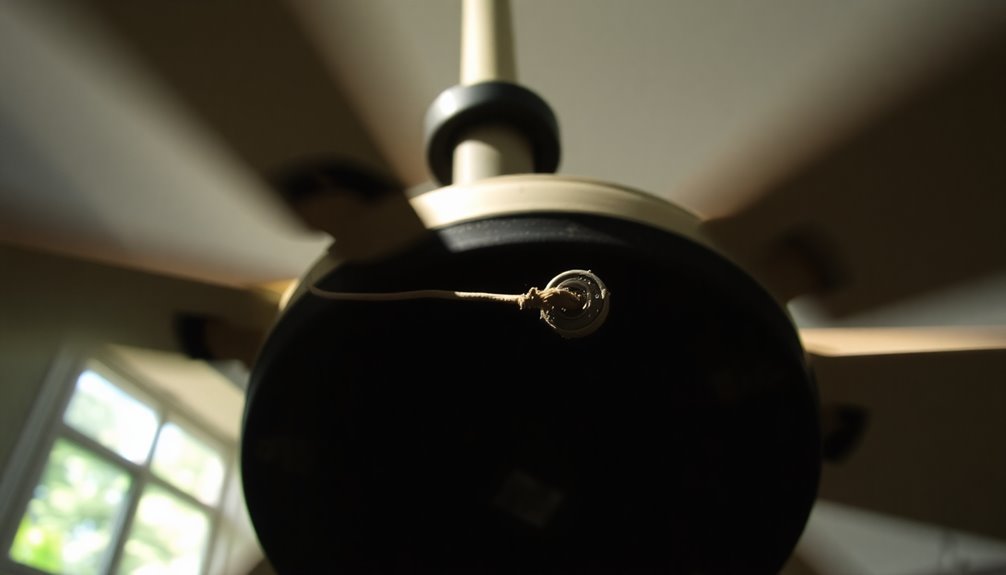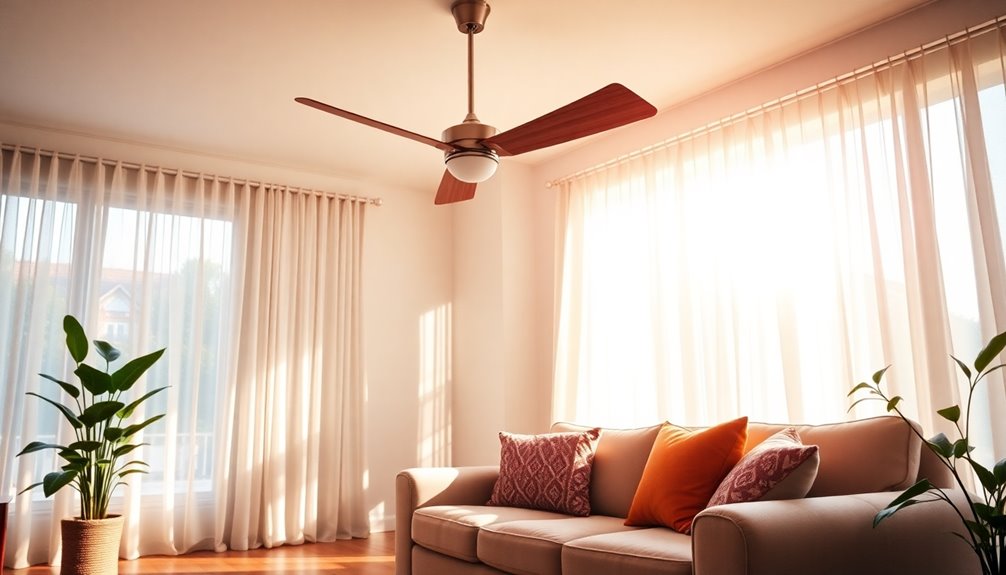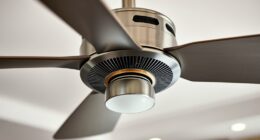In summer, you want your ceiling fan to spin counterclockwise. This direction creates a cool downdraft that enhances airflow and makes your space feel more comfortable. You can actually raise your thermostat settings by about 4 degrees without losing that cool sensation. Not only does it keep you cooler, but it also helps save on energy costs—up to 30%! Just remember to switch it back to clockwise in the fall to circulate warm air. For tips on changing the direction and maximizing your fan's efficiency, there's more useful information waiting for you.
Key Takeaways
- In summer, a ceiling fan should rotate counterclockwise to create a cooling downdraft and enhance comfort.
- Counterclockwise rotation improves airflow, allowing thermostat settings to be raised without sacrificing comfort.
- Proper blade angle of at least 12 degrees is essential for effective cooling airflow.
- Regularly adjust fan direction in spring for summer cooling and switch to clockwise in fall for warmth.
- Ensure the fan is completely stopped before changing its direction for safety and effectiveness.
Importance of Ceiling Fan Direction

When it comes to staying comfortable during the hot summer months, the direction of your ceiling fan plays an essential role. Running your ceiling fan in a counterclockwise direction creates a cooling downdraft that enhances your comfort through the wind chill effect. This simple adjustment can make a significant difference in how cool you feel, allowing you to raise your thermostat setting by about 4 degrees without sacrificing comfort. Additionally, using a ceiling fan helps reduce the workload on your heat pump system, allowing for more efficient operation. Properly maintained air quality can further enhance your comfort by ensuring a fresher indoor environment. Furthermore, the Seasonal Energy Efficiency Ratio (SEER) ratings of your cooling system can also be improved with better airflow from ceiling fans.
Improper ceiling fan direction can lead to inadequate airflow, leaving you feeling hot and prompting you to rely heavily on your air conditioning system. By ensuring your fan is set to summer mode, you can improve overall energy efficiency in your home. This not only enhances your comfort but can also reduce cooling costs by up to 30%. Additionally, using a ceiling fan in conjunction with energy-efficient heat pumps can further optimize your indoor climate control, maximizing both comfort and savings. In fact, proper airflow from your ceiling fan can significantly enhance the effectiveness of your heating and cooling systems.
Understanding the importance of ceiling fan direction is essential for maximizing both comfort and savings. So, make sure to check your fan's direction regularly to enjoy a more pleasant indoor environment while keeping your energy bills in check.
Proper airflow from your ceiling fan can transform your space into a cool oasis, letting you beat the summer heat effectively.
Summer Fan Direction Guidelines

To maximize your comfort during the sweltering summer months, set your ceiling fan to rotate counterclockwise. This ceiling fan direction creates a cooling downdraft that enhances your comfort level by generating a wind chill effect.
As the air circulates, you'll feel cooler without needing to lower your air conditioning temperature.
When the fan turns counterclockwise, you can actually raise your thermostat settings by about 4 degrees, leading to impressive energy savings. This means you can enjoy a comfortable environment while reducing energy costs.
For peak cooling during the summer months, make sure that the angle of the fan blades is set at a minimum of 12 degrees. This positioning is essential for maximizing airflow and achieving that desired cooling effect.
Don't forget about outdoor ceiling fans; they should also rotate counterclockwise to provide a consistent cooling experience in your outdoor spaces.
How to Change Fan Direction

To change your ceiling fan's direction, start by turning it off and letting it stop completely.
Depending on your fan's design, you might use a pull chain, a remote, or a smart app to adjust the direction.
Once you've made the change, turn the fan back on to guarantee it's set for ideal airflow this summer.
Changing Direction Mechanism
Changing the direction of your ceiling fan is a straightforward process that assures ideal airflow in your space. To start, make sure to turn the fan off and let it come to a complete stop.
If your fan has a pull chain, locate the ceiling fan switch on the fan body to change the direction. This will allow the ceiling fan blades to spin counterclockwise, creating a cooling breeze ideal for summer.
For remote-controlled fans, verify the remote is paired with the fan. Turn the fan off, then press and hold the designated fan button until a light blinks, indicating that you've successfully changed the direction.
If you have a smart fan, you can easily adjust its direction using compatible apps or voice commands through SIMPLEconnect® WiFi® technology.
Once you've made the necessary adjustments, turn the fan back on to confirm it's operating in the desired rotation.
Proper Seasonal Timing
After you've successfully adjusted your ceiling fan's direction for summer, timing your changes becomes important for maximizing comfort and efficiency.
To make the most of your ceiling fan direction, aim to change your ceiling fan's rotation during Daylight Savings Time. In spring, switch the blades to rotate counterclockwise, allowing for the cool air to be pushed downward, which helps to keep your space comfortable.
When summer temperatures rise, verify your fan is off and has come to a complete stop before making adjustments. If you have a pull chain fan, locate the reversing switch on the fan body to set the blades appropriately.
For remote-controlled fans, turn off the fan, then press and hold the fan button until a light blinks, indicating the direction has changed. If you're using a smart fan equipped with SIMPLEconnect® WiFi® technology, you can simply adjust the fan direction through an app or voice commands.
As the seasons change, switch back to a clockwise rotation in fall to circulate warm air.
This seasonal performance strategy keeps your home comfortable year-round, saving energy and enhancing your comfort.
Optimal Timing for Direction Change

As the seasons shift, timing your ceiling fan direction change becomes vital for maximizing comfort and energy efficiency.
The ideal timing for adjusting ceiling fans direction is during Daylight Savings Time adjustments. When you spring forward in the spring, it's time to switch your fan to summer mode. Set it to spin counterclockwise to create a cooling downdraft that helps keep you comfortable during warmer months.
Conversely, when you fall back in the autumn, remember to adjust fan direction to clockwise. This rotation helps circulate the warm air that rises to the ceiling, improving heating efficiency during colder months.
It's also important to verify that your ceiling fan is appropriately sized for your room. A well-sized fan enhances performance and effectiveness when you switch directions seasonally.
Regularly checking and adjusting the fan direction according to the season can greatly impact overall energy consumption and comfort levels in your home. By being proactive about your ceiling fan settings, you'll not only enjoy a more pleasant environment but also save on energy costs throughout the year.
Ceiling Fan Benefits in Summer

In summer, using a ceiling fan can greatly enhance your comfort while keeping energy costs down.
By running the fan counterclockwise, you create a cooling downdraft that makes you feel cooler, allowing you to raise your thermostat setting without sacrificing comfort.
Plus, with their low energy consumption, ceiling fans provide ideal air circulation at a fraction of the cost of air conditioning.
Energy Cost Savings
Ceiling fans can greatly reduce your energy costs during the summer months. By setting your ceiling fan to spin counterclockwise, you'll create a cool breeze that makes the room feel up to 4 degrees cooler. This allows you to raise your thermostat settings, which can lead to significant savings on your air conditioning bill.
In fact, running a ceiling fan can reduce air conditioning costs by up to 30% by simply enhancing airflow.
Here are some benefits of using a ceiling fan in summer:
- Lower energy bills from reduced reliance on air conditioning
- Cooler rooms without drastic temperature changes
- Energy consumption of only 50 watts, compared to 3,500 watts for air conditioning
- Enhanced airflow that increases comfort and efficiency
- Pairing with ENERGY STAR-rated systems for an additional 8% cooling efficiency
Utilizing a ceiling fan properly not only keeps you comfortable but also minimizes your energy consumption and costs.
Embrace this simple yet effective solution for your summer cooling needs!
Enhanced Comfort Levels
Using a ceiling fan not only helps save on energy costs but also considerably boosts your comfort levels during the hot summer months. When you make sure your ceiling fan turns counterclockwise, it creates a cooling downdraft that produces a revitalizing wind chill effect. This simple adjustment can make a significant difference in how you feel indoors.
Here's a quick overview of the benefits:
| Benefit | Explanation |
|---|---|
| Enhanced Comfort Levels | Feel cooler even at higher thermostat settings |
| Cooler Air | Creates a breeze that lowers perceived temperature |
| Reduce Energy Costs | Decrease reliance on air conditioner |
| Fan Direction in Summer | Counterclockwise rotation maximizes airflow |
| Change the Ceiling Fan Direction | Regular adjustments make sure year-round comfort |
Optimal Air Circulation
When you optimize air circulation with a ceiling fan running counterclockwise, you can greatly enhance your indoor comfort during the sweltering summer months. This rotation creates a rejuvenating downward breeze that amplifies the wind chill effect, making the air feel cooler around you. Additionally, using ceiling fans in conjunction with an air purifier can further improve overall well-being by enhancing indoor air quality. Best HEPA filter vacuums can also help in maintaining a cleaner environment, which complements the benefits of a ceiling fan. Moreover, choosing energy-efficient models ensures that your ceiling fan operates effectively while saving on electricity costs.
By using a ceiling fan, you can even raise your thermostat settings by about 4 degrees while still feeling comfortable, leading to significant energy savings. Additionally, high-end ceiling fans often come with energy-efficient motors that help reduce electricity consumption even further.
Imagine the benefits:
- A gentle breeze soothing your skin as you relax in your living room
- A cooler bedroom atmosphere for a restful night's sleep
- Reduced reliance on your air conditioning unit, cutting down on energy bills
- An eco-friendly approach to staying cool during the hot summer days
- The satisfaction of knowing you're optimizing your home's airflow
- Incorporating aquatic exercise can also help you stay cool and active during the summer months.
To maximize cooling, verify your ceiling fan blades are angled at least 12 degrees.
Pairing your ceiling fan with an ENERGY STAR-rated air conditioning unit can boost cooling efficiency by up to 8%. With ceiling fans consuming only 50 watts compared to 3,500 watts for air conditioning, you're taking an effective step towards better air circulation and energy conservation this summer.
Energy Efficiency Tips for Fans

Regularly enhancing your ceiling fan's performance can greatly boost energy efficiency during the summer months. Set your ceiling fan to rotate counterclockwise to create a cooling downdraft that enhances comfort and reduces your reliance on air conditioning. By doing this, you can raise your thermostat settings by about 4 degrees, leading to potential savings on cooling costs.
Using a ceiling fan consumes around 50 watts, while an air conditioning unit typically uses about 3,500 watts. This stark difference highlights significant energy savings. To improve cooling efficiency, consider pairing your ceiling fan with an ENERGY STAR-rated air conditioning system, which can enhance overall cooling efficiency by up to 8%.
Regular maintenance is also key to maintaining energy efficiency. Clean the blades frequently and verify the blade angle is set correctly for ideal airflow. Additionally, ensuring proper airflow around the unit can enhance performance, similar to how filter maintenance improves air purifier efficiency.
These simple steps will enhance your ceiling fan's performance and help manage your cooling costs. By implementing these energy efficiency tips, you'll enjoy a cooler summer while keeping your energy bills in check.
Frequently Asked Questions
How Do You Tell if a Fan Is Going Clockwise or Counterclockwise?
To tell if a fan's going clockwise or counterclockwise, stand directly under it and feel for a breeze.
If you feel air moving down towards you, it's spinning counterclockwise. If there's little to no airflow, it might be going clockwise.
You can also look for the reverse switch on the fan; flipping it changes the direction.
Do Ceiling Fans Cool a Hot Room?
Ceiling fans don't actually cool a hot room, but they create a wind chill effect that makes you feel cooler.
When you run your fan, it circulates the air around you, allowing heat to escape from your skin. You can enjoy a more comfortable temperature without cranking up the air conditioning.
Plus, it's energy-efficient, letting you raise your thermostat without sacrificing comfort.
How to Tell Fan Direction?
To tell the fan direction, stand directly underneath it and feel for a breeze. If you notice a cool air flow, the fan's likely spinning counterclockwise.
No breeze? It's probably rotating clockwise.
You can also check for a reverse switch on the motor or a button on the remote, which lets you easily change the blade direction.
Visualize clock hands: counterclockwise is left and clockwise is right.
Which Way Should a Ceiling Fan Turn in Summer Reddit?
If you're wondering which way your ceiling fan should turn during summer, it's important to know it should rotate counterclockwise.
This direction creates a cooling downdraft, enhancing your comfort by pushing cooler air down.
You can easily check the fan's direction by standing underneath it; if you feel a breeze, it's correct.
Don't forget to adjust the switch or remote to guarantee it's set for summer use!
Conclusion
In summer, you want your ceiling fan to spin counterclockwise, creating a cool breeze that makes you feel up to 8 degrees cooler. Did you know that using a ceiling fan alongside your air conditioner can help reduce energy costs by up to 30%? So, by adjusting your fan direction and following a few simple tips, you can stay comfortable while saving money. It's a win-win for both you and your wallet!









